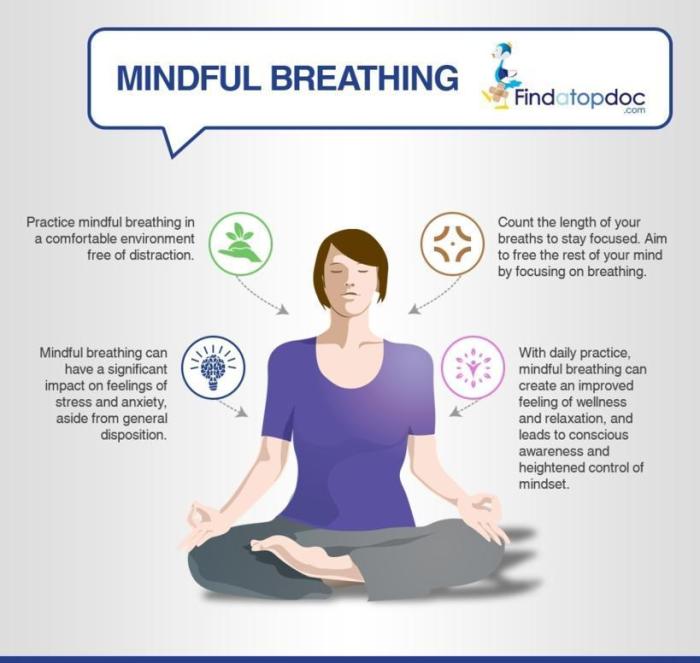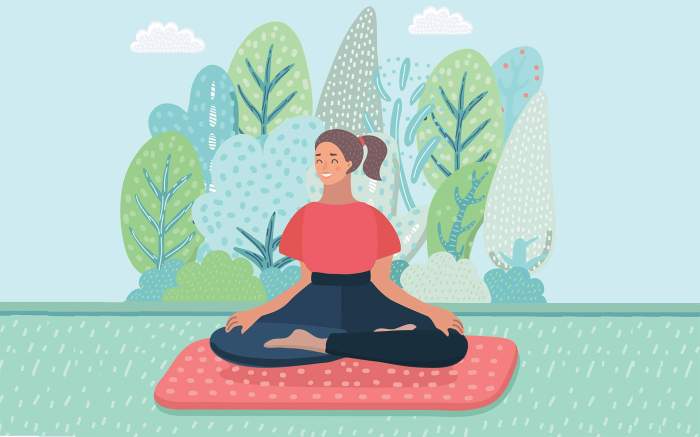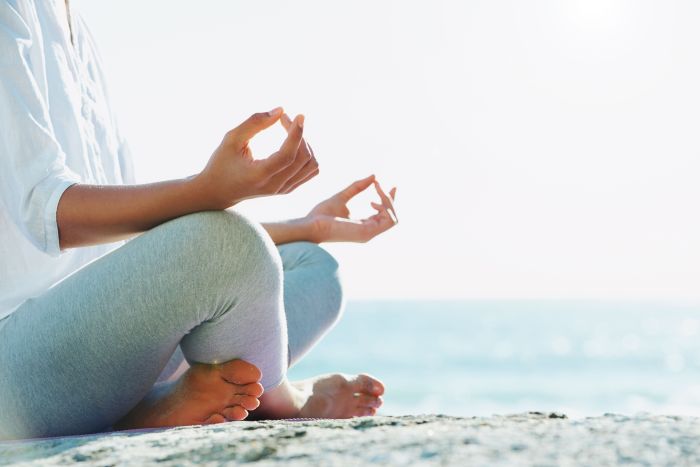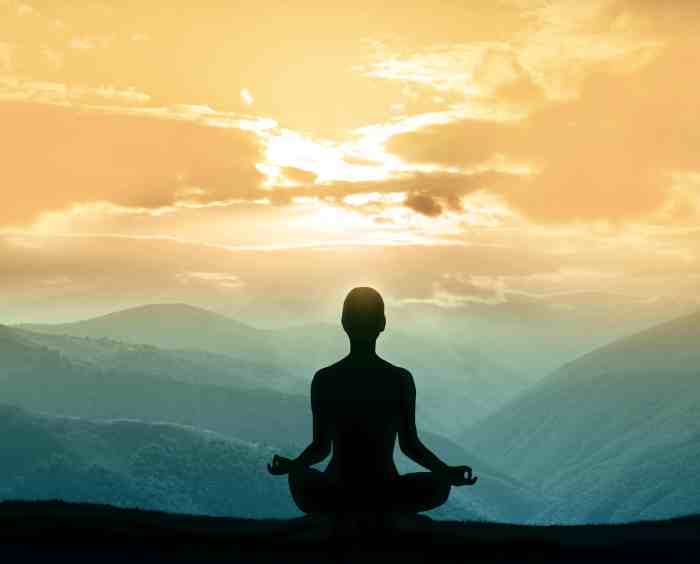How to Meditate for Deep Breathing and Relaxation sets the stage for a journey into the realm of mindfulness and inner peace. As we delve into the intricacies of meditation practices, the art of deep breathing, and the profound benefits of relaxation, we uncover a path towards holistic well-being and tranquility.
Exploring the essence of deep breathing and its symbiotic relationship with meditation opens doors to a realm of self-discovery and profound serenity.
Introduction to Meditation for Deep Breathing and Relaxation

Meditation is a practice that involves focusing the mind and eliminating distractions to achieve a state of calm and clarity. It has numerous benefits, including reducing stress, improving concentration, and promoting emotional well-being.
Reducing tension and improving flexibility are key benefits of meditation. By incorporating specific techniques into your practice, you can release stress and increase your body’s range of motion. To discover how to meditate for reducing tension and improving flexibility, check out this helpful resource: How to Meditate for Reducing Tension and Improving Flexibility.
Incorporating deep breathing into meditation helps to increase oxygen flow to the brain and body, promoting relaxation and reducing tension. Deep breathing techniques can also help to calm the nervous system and lower blood pressure, enhancing the overall meditation experience.
The Connection Between Relaxation and Deep Breathing During Meditation
- Deep breathing helps to activate the body’s relaxation response, triggering the parasympathetic nervous system and reducing the production of stress hormones.
- Relaxation is essential during meditation as it allows the mind to let go of worries and distractions, creating a peaceful and focused state of being.
- By combining deep breathing with meditation, individuals can experience a deeper sense of relaxation, heightened awareness, and increased mindfulness.
Setting Up a Comfortable Space for Meditation

Creating a peaceful environment for meditation is crucial for deep breathing exercises. The right space can enhance relaxation and focus during your practice.
Choosing a Quiet and Comfortable Space, How to Meditate for Deep Breathing and Relaxation
When selecting a space for meditation, opt for a room or area that is quiet and free from distractions. Choose a spot where you feel comfortable and at ease. This could be a corner of a room, a designated meditation area, or even outdoors in a quiet garden.
Strengthening the mind is essential for overall well-being. Meditation is a great way to achieve mental resilience and inner strength. If you’re interested in learning how to meditate to strengthen your mind, here are 5 tips to help you get started: How to Meditate to Strengthen Your Mind: 5 Tips.
- Avoid spaces with loud noises or frequent foot traffic to maintain a peaceful atmosphere.
- Ensure the area is clean and clutter-free to promote a sense of calm and tranquility.
- Use a comfortable cushion or mat to sit on during meditation to support your posture and enhance relaxation.
Significance of Lighting and Temperature
The lighting and temperature of your meditation space can greatly impact your practice.
When it comes to improving cognitive function, meditation can be a powerful tool. By practicing mindfulness and focus, individuals can enhance their mental clarity and overall brain function. To learn more about how to meditate for improving cognitive function, check out this comprehensive guide: How to Meditate for Improving Cognitive Function.
- Choose soft, natural lighting or dim lighting to create a soothing ambiance for meditation.
- Avoid harsh or bright lights that can be distracting or cause strain on your eyes.
- Maintain a comfortable temperature in the room to prevent discomfort during meditation. Too hot or too cold temperatures can interfere with relaxation.
- Consider using essential oils or candles with calming scents to enhance the atmosphere and promote relaxation.
Breathing Techniques for Deep Relaxation: How To Meditate For Deep Breathing And Relaxation

Deep breathing techniques are essential for relaxation as they help calm the mind and reduce stress. Let’s explore some popular techniques and their benefits for deep relaxation.
Diaphragmatic Breathing
Diaphragmatic breathing, also known as abdominal breathing, involves using the diaphragm to take deep breaths. This technique helps increase oxygen flow in the body, reduce heart rate, and promote a sense of calmness. Here’s how to perform diaphragmatic breathing effectively:
- Sit or lie down in a comfortable position.
- Place one hand on your chest and the other on your abdomen.
- Inhale deeply through your nose, allowing your abdomen to expand while keeping your chest still.
- Exhale slowly through your mouth, feeling your abdomen contract.
- Repeat this process for several minutes, focusing on the rise and fall of your abdomen.
Box Breathing
Box breathing is a technique that involves inhaling, holding the breath, exhaling, and holding the breath again in a four-count pattern. This method helps regulate breathing and induce a state of relaxation. Here’s how to practice box breathing for deep relaxation:
- Sit in a comfortable position with your back straight.
- Inhale deeply through your nose for a count of four.
- Hold your breath for a count of four.
- Exhale slowly through your mouth for a count of four.
- Hold your breath again for a count of four.
- Repeat this cycle for several minutes, focusing on the rhythm of your breath.
Guided Meditation Practices for Relaxation

Guided meditations play a crucial role in enhancing relaxation and deep breathing by providing verbal instructions and soothing guidance to help individuals focus their minds and achieve a state of calm. These practices can be especially beneficial for beginners or individuals looking to deepen their meditation experience.
Examples of Guided Meditation Scripts or Apps for Deep Relaxation
- Insight Timer: This popular meditation app offers a wide range of guided meditations for relaxation, sleep, stress relief, and more, catering to different preferences and needs.
- Calm: Known for its soothing nature sounds and guided meditation sessions, Calm provides various guided practices focused on relaxation, mindfulness, and deep breathing.
- Headspace: With a user-friendly interface and a variety of guided meditations led by experts, Headspace is a great option for those seeking relaxation and stress reduction through meditation.
Visualization Techniques for Deepening the Relaxation Experience
Visualization techniques involve mentally picturing calming scenes, such as peaceful landscapes or serene environments, to promote relaxation and enhance the meditation process. By engaging the mind in vivid imagery, individuals can deepen their sense of relaxation and focus, ultimately leading to a more profound meditative experience.
During guided meditation, visualization techniques can help create a sense of tranquility and inner peace, allowing individuals to let go of stress and tension more effectively.
In conclusion, mastering the art of meditation for deep breathing and relaxation is a transformative experience that nurtures the mind, body, and soul. Embrace the tranquility within and embark on a journey towards inner harmony and vitality.